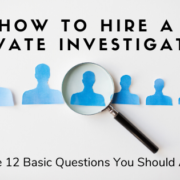Red Flags – The Ultimate List for Workers’ Compensation Claims Fraud
A new workers’ compensation claim hits your inbox, littered with red flags. But your spidey- sense kicks in. Why?
Well, several warning signs pop up; the claimant was injured on a Friday before a holiday weekend, they’ve already booked appointments with a chiropractor, and nobody witnessed the injury.
You ask yourself, “Is it fraud?!?”
Though not every claim you see is fraudulent, this one appears to be. But, what now?
You know that proving fraud could save your client tons of money in insurance premiums.
What if you had a comprehensive list of red flags to check against your suspicions? A list that was compiled by a fraud investigator with the help of claims professionals like you?…
..well, we did it.
We asked a dozen claims adjusters, examiners, insurance professionals, attorneys, and others for their workers’ compensation claim advice and compiled the results into a comprehensive list.
Here is the list of red flags (67 total) they provided:
The Timeliness of the Injury Report
- The injury occurred immediately before a holiday or a long weekend (many “injuries” occur on Fridays). – The most common red flag is the injury without a timely report of injury – Lisa Fike, Staff Attorney
- The claimant was injured after a holiday or a long weekend (this repeatedly occurs if the claimant is ineligible for holiday or paid-time-off).
- The claim was filed prior to a planned vacation allowing the claimant to collect disability during their trips.
- The claimant reports the accident days, weeks, months, or years after it occurred.
- The claim is filed after the claimant becomes aware of their imminent termination.
- The claimant is injured shortly after initial hiring (this is especially true after the initial probationary period for full-time hires).
- The claimant recently purchased personal disability insurance (a.k.a. gap coverage).
- The claimant hires an attorney immediately after filing a claim.
- The claimant instantly asks for a settlement.– Amy Rodallega, Claims Representative, Nationwide Insurance
The Accident
- There were no witnesses to the accident.
- The accident occurred on the employer’s premises but out of view of security cameras.
- The claimant was helping another employee despite being asked not to do so (not their department or job duties) by management.
- The claimant’s version of the accident is inconsistent – there are multiple variations of the story.
The Injury
- The claimant experiences a psychological injury, which is hard to substantiate.
- The claimant experiences a back injury, which is hard to substantiate.
- The claimant engages in physical activities inconsistent with the limitations they claim to have due to their injury.
- The claimant has a pre-existing injury.
- A hospital canvass determines that the claimant has been treated elsewhere for the same condition and/or an Insurance Service Office (ISO) check reveals that the claimant had prior injuries to the same body part. – Lori Terry, Claims Examiner, Careworks Consultants Inc.
- The claimant has a history of subjective injuries, psychological, mental pain, undisclosed pain, or general pain.
- The claimant seeks to open or start a new claim based on a flow-through injury (an injury developing in a body part not originally alleged) or from the result of an old injury. – Jean McEntarfer, Human Resources Manager, Teleperformance USA
Communication
- The claimant is never available to answer calls.
- The claimant has limited availability for exams and/or appointments.
- The claimant has a preference for receiving emails from claim representatives rather than phone calls.
- The claimant’s voicemail box is always full.
- The claimant screens or avoids calls.
- The claimant frequently changes appointments or does not show for appointments to avoid field case manager or nurse case manager. – Debbie Lantman, Manager – Workers’ Compensation, Formica Corporation
Circumstances Around the Job
- The claimant files a claim for job security – the claimant knows the employer will not terminate the claimant while on disability.
- The claimant performs seasonal work that will end soon.
- The claimant is approaching retirement and files a claim.
- The claimant has absenteeism problems.– “They ‘earn and burn’ their time by attempting to get off work when they’re out of PTO or off-days.” – Brenda Scalf, Client Services Manager, Sheakley
- The claimant has frequently used the Family Medical Leave Act (FMLA).
- The injury occurred as a result of the claimant’s side job.
- The claimant has a personal vendetta against management or fellow employees.
- The claim occurred just prior to or after a strike.
- The claimant shows up in pictures or in person with indications of having worked another job:
- they have calluses on their hands, or
- grease under their fingers.
The Physician
- The physician of record (POR) does not mention checking the state pharmacy website for the claimant’s narcotic prescriptions.
- In states where it’s permissible to do so, the claimant refuses to seek medical treatment or physical therapy.
- Multiple workers’ compensation claimants seek out the same physician. -“It’s suspicious when employees of the same organization magically go to the same doctor when they are injured.” – Kelly Flynn Reimer, Claims Manager
- The claimant refuses to go to vocational rehabilitation.
- The claimant refuses to go to an independent medical exam (IME).
- The subject explores “doctor shopping,” where they seek out physicians who substantiate their injury claims. –“I would say that anyone who gets released from the physician, or is told they can’t have any more narcotics/meds, who then immediately starts ‘doctor shopping’ is a big red flag.” – Jill Thomas, Director of Claims, V&A Risk Services, LLC
- The claimant seeks narcotics and once their prescription runs out, they shop for another doctor who will fill that prescription.
- After a doctor’s appointment, the claimant cannot describe the types of medical services that were performed on him or her.
- The claimant has a doctor that is a great distance from their residence for no reason at all.
- The claimant tells the doctor what kind of treatment they need.
- The claimant tells the doctor their employer has no light-duty work.
- The claimant immediately seeks treatment with a doctor or chiropractor that is known to automatically take patients off work. “Some doctors are on the suspicious provider list if claimants go to them for initial treatment. Suspicions increase when employees of the same organization frequent the same physicians” – Anonymous Claims Professional
- The claimant sells their prescriptions to others or seeks out various medical providers to obtain multiple prescriptions.
- The injured worker immediately schedules a meeting with a chiropractor. -“Even if I’m not familiar with that chiropractor, that’s always a red flag to me because it means the injured worker (IW) is familiar with chiropractors” – Jackie Spring, Self-Insured Manager, Alternative Risk Management
Character-Related Suspicions
- Social media pictures and profile information indicate that the claimant is active and moving normally against their restrictions. – Lisa Ball, SIU, Allstate Insurance
- The claimant has a history of filing Worker’s Compensation claims in the past.– “I have seen people do this because most employers will not get rid of someone that has filed a workers’ comp claim.” – Debra Goetz, Spooner Inc.
- Employees that are friends or associates with the claimant observe the claimant conducting activities that are in contradiction to their limitations.
- The injury occurred during a side sporting activity.
- The claimant is a nomad; they live in multiple places, and/or drive around from job to job.
- The claimant uses a PO Box as their mailing address, rather than an actual address, and/or refuses to provide a physical address.
- The claimant lives in an economically depressed area.
- The claimant has a history of bad credit, monetary problems, or is always in debt.
- Several of the claimant’s relatives and friends have similar Worker’s Compensation claims. This is what some investigators call ‘fraud school,’ where fraud/abuse methods are passed from relative to relative.
- When taking a claimant’s statement, the claimant feels inclined to provide information on their personal character. For example, “I’m a good person, and I am not looking to scam the system or get something I don’t deserve.’ I can tell you that 9 times out of 10 when someone makes a comment like that to me they end up trying to scam the system!” – Adriane R. Thompson, SCLA, Senior Resolution Manager, Gallagher Bassett
- Claims representatives suspect the claimant’s character or personality traits determine the claimant is engaged in workers’ compensation fraud or abuse (The claimant’s demeanor is very calm or savvy).
Other Red Flags
- The claimant does not have medical insurance.
- The claimant opts out of employer-provided health insurance and soon after files a workers’ compensation claim.
- The claimant has a high-deductible insurance meaning they’ll pay a lot in out of pocket expenses.
- The employee will file a claim before going out for a non-industrial health reason (i.e. major surgery) & their PTO time won’t cover the entire period of time they’re off.
- Employees who plan to visit their out-of-the-country/town family members for extended periods of time will file a temporary total disability (TTD) claim, allowing them to collect a Workers’ Compensation check if their doctor writes them off on a Physician’s Report of Work Ability. “For example, someone from a foreign country who is planning to visit their family for 1-2 months will file a claim the week just before they leave thinking they will be paid TTD the entire time they are gone.” – Holly Miller, The Ohio Manufacturer’s Association
- The claimant has shown an overall pattern of behavior that indicates fraud.
- The claimant had a recent auto accident or has had multiple auto accidents where they were injured.
What now?
When that next claim with red flags hits your inbox, do your clients a favor – check it against the list above. If it saves them money, they’ll be happy you did.
Did we leave out any red flags? Let us know in the comments below or email Gravitas Investigations at adam@gravitasinv.com with your suggestion.
If you’d like to discuss a plan to combat fraud, Call Us Now to speak directly with an investigator.









